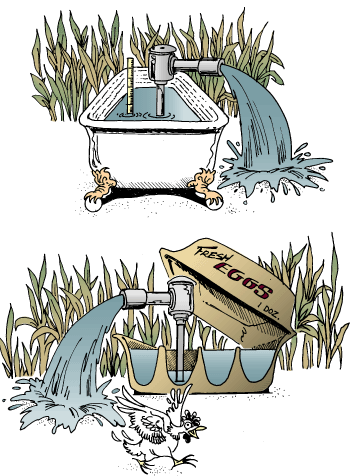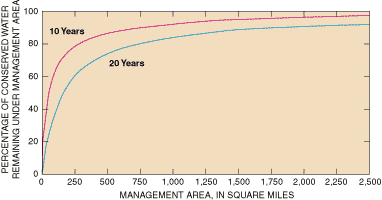
Sustainability of Ground-Water Resources--Circular 1186
A key question related to ground-water sustainability in intensively irrigated areas is the extent to which individual irrigators have incentive to consider the effect of their current pumping decisions on their own future pumping costs. For example, if an irrigator could be sure that water not pumped today would be available for use later, he or she might change their pumping strategy to use the water more efficiently over time.
As an example, in the early 1980s questions were posed in economic forecasting for the High Plains aquifer as to whether the aquifer could be treated, from an individual irrigators point of view, as an "egg carton" or a "bathtub" (Beattie, 1981). The egg carton analogy assumes that users of ground water are not seriously subject to depletion by the actions of neighboring irrigators because of the local nature of the cone of depression formed around an individual pumped well, particularly for an unconfined aquifer (see Box A). The bathtub analogy, on the other hand, views the aquifer as a common pool in which water levels respond to pumping as though water were being withdrawn from a bathtub or lake. In such a system, an increase in withdrawal by one irrigator immediately translates into an increase in pumping lifts for all irrigators.

The actual situation lies somewhere between these two analogies. Water pumped by a well is withdrawn from the aquifer within the vicinity of the well; however, the cumulative effects of pumping many neighboring wells over many years result in regional water-level declines. These regional declines in water levels limit the influence that an individual irrigator has over his or her own future pumping lifts. The local effects of changes in the magnitude and direction of gradients in the water table also must be considered. That is, the net effects of the reduced pumping from a well will be distributed over an area that increases with time and that may not be limited to the well owners property. The end result is that the decreases in water withdrawals do not result in an equivalent future increase in ground-water storage directly under the pumped area.
A hypothetical pumping scenario illustrates these effects (Alley and Schefter, 1987). In this scenario, pumping is reduced from a base level by 25 percent for 10 years within management areas of various sizes in the High Plains. The effect of the reduced pumping was simulated for 10 years and 20 years from the start of the water-conservation program; that is, at the end of 10 years of conservation and at 10 years after conservation ended. The results, shown in Figure D-1 for both time periods, demonstrate that individual irrigators operating at the local scale have limited ability to "bank" water to decrease their future pumping lifts, but that opportunity exists at larger management scales to effectively reduce future pumping lifts. For example, after 20 years much less than 10 percent of the conserved water remains under areas of a few square miles or less (the size of many farms); but this increases to about 60 percent for areas of 250 square miles and to more than 85 percent for management areas in excess of 1,000 square miles. The results illustrate the potential usefulness of ground-water management areas and provide some insight into the effectiveness of different size areas.

Figure D-1. Percentage of water conserved by reduced pumping that provides increased ground-water storage under hypothetical management areas of different size overlying the High Plains aquifer. (Modified from Alley and Schefter, 1987.)